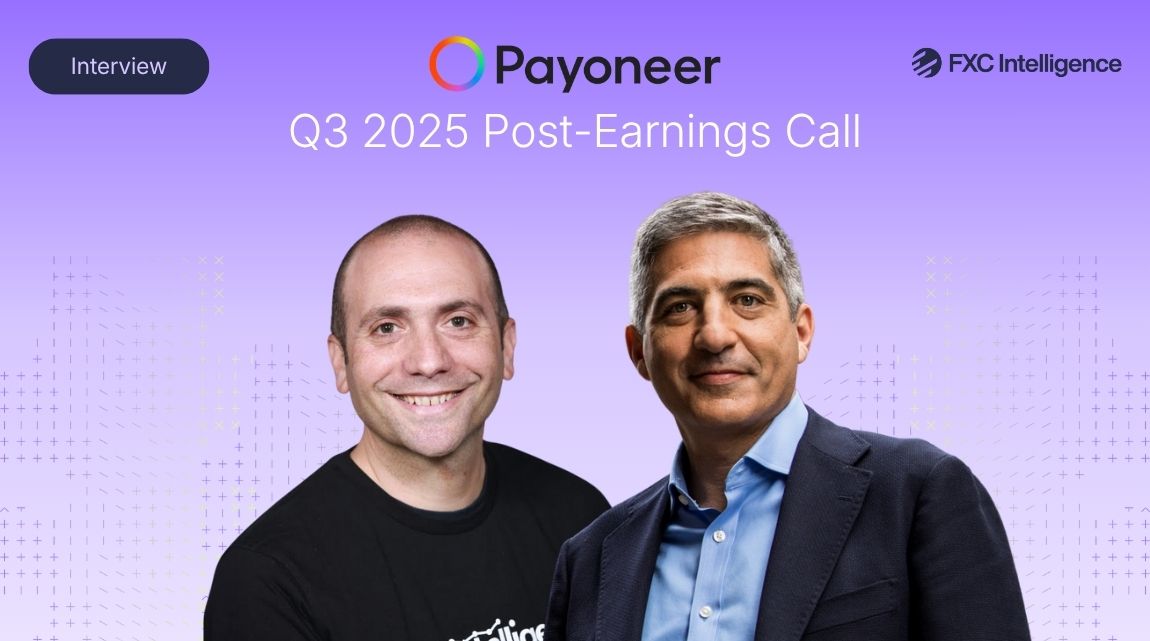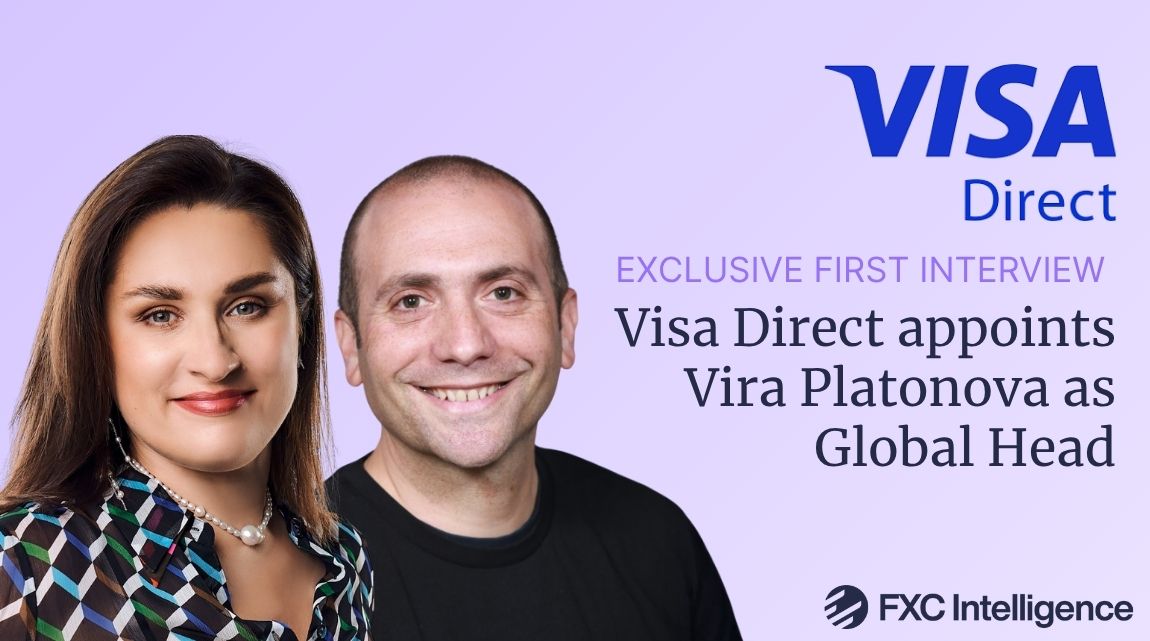In our latest report in our Post-Earnings Call Series, Payoneer CEO Scott Galit discusses the company’s impressive Q3 2021 earnings and plans for future growth.


Payoneer’s Q3 2021 results have seen the company significantly exceed expectations, with a 35% year-on-year revenue increase to $123m as well as a 16% increase in volume and a notably improved take rate.
The company has also grown its presence globally, seeing 50%+ growth in a number of emerging markets, and overall adding record numbers of new customers in the quarter. Meanwhile, it is expanding its efforts beyond its core product areas, including with the launch of Payoneer Checkout.
With the pandemic’s impact on ecommerce now beginning to stabilise, how is Payoneer finding its impressive growth, and how is it diversifying its offering to maintain long-term success? Daniel Webber spoke to Payoneer CEO Scott Galit to find out.
Payoneer’s key growth drivers
Daniel Webber: Let’s start at the top. A very nice set up earnings; 35% up on revenue, 16% up on volume. What’s driving the growth?
Scott Galit:
Part of what’s great about our business overall, and I think it got lost a little bit as ecommerce surged so much during Covid, is that we actually have a really broad and diverse set of vertical markets that we serve; a broad set of geographies that we serve; a broad range of customer sizes that we serve.
What was great this quarter is it highlighted that the things that we control are actually going well and then there’s a number of parts of the world and vertical markets that are doing well. So in spite of some challenges in the broader ecommerce ecosystem landscape, where you see eBay reporting volume down 10% year-over-year, Wayfair was down almost 20% in volume year-over-year, we were able to deliver on a broad range of geographies with really strong growth. A broad range of our services that are higher take rate, high-value services like our B2B AP/AR service, which is now up to 10% of our volume, which we disclosed this quarter.
The growth of our new virtual commercial card, which is at a meaningful, full premium from a take rate perspective. Our global sales teams in those markets around the world actually further penetrating what we see as just a huge market opportunity. All of these things are doing well.
We’re executing well on all of our strategies. Then have this part of the business with ecommerce that’s dependent on some broader trends where supply chain and logistics issues combined with changing and evolving consumer behavior coming out of Covid are all creating a little bit of noise over on that part.
That’s part that had the market nervous about what our results might look like. And we’re really thrilled that we were able to deliver strong results and highlight some of the real breadth, diversity and execution strength in the business.
Figure 1
Payoneer’s Growth Prospects

Building growth in emerging markets
Daniel Webber: You’ve had some nice growth in emerging markets, particularly in Latin America, South Asia, Middle East and North Africa. How do you see those markets in the context of the overall business?
Scott Galit:
Those are markets that have been foundational for us for a long time. Some of them are markets that we’ve come a little bit more recently to, making a meaningful investment in sales, our go-to-market and our partnerships activities. Those efforts are being successful and effective.
We’ve got a terrific team that we’ve been building in Latin America. Mar Fernández who leads that team for us, she’s fantastic. We’re getting a lot of traction as our teams are going out and talking to exporters.
There’s a different mix in some of these markets, and also the range of sizes of customers is wider. So some of these markets have higher take rates. We have a higher percentage of customers that are on the smaller end of the spectrum as opposed to the bigger end of the spectrum.
We had a record number of new customers globally in this past quarter with a broad range of strength coming from in a lot of different markets around the world. So our go-to-market activities are firing on all cylinders. Partnerships are driving new customer acquisition, our self-serve platform with tremendous acquisition, our sales teams are driving acquisition and our marketplace is driving acquisition.
All of these are going well, and we are increasing our investments more in these markets that would be considered long-tail markets. We’ve been ramping up teams in markets in Eastern Europe, Latin America, the Middle East, South Asia, East Asia. All of these are regions where we think we’re just super early in terms of the penetration of some of these opportunities in particular as we start to move from the really small sellers of services and goods, up to the next level up, which is what our sales teams tend to focus on.
We think there’s a lot of opportunity there and we’ve got a great value proposition. So we’re really excited. We’re leaning in more and more on that investment. And as a result, what you’ll see is a continuing broadening of the drivers of growth in the business with a mix that’ll take us more into higher take rate markets, as opposed to lower take rate markets.
Figure 2
Payoneer’s Growth Prospects

Payoneer’s value proposition
Daniel Webber: What’s your value proposition, and what’s the mix between getting paid and making payments?
Scott Galit:
For large enterprises, the foundational value proposition is accounts payable, and for our small businesses around the world, the foundational value proposition has been accounts receivable.
Those are broadening and diversifying as well in both directions. We now have our merchant services offering helping enterprises on the receivable side, and we now have a variety of tools that we’re providing to help our small business customers on the payable side.
But most of that payable side activity and expense side activity starts with a customer using us for receivables. Receivables is the anchor service. Marketplace receivables has been the foundational service for us for a long time, but now we have much faster growth in our B2B accounts receivable capabilities.
This is off marketplace, the ability to build customers get paid with a variety of local payment methods in different markets. So think of it as a global billing capability for small and medium size businesses available through online interfaces, through APIs, through bank partnerships that our customers are accessing that.
That is growing much quicker than the business overall, it’s also a higher take rate than the business overall. Once our small business customers have gotten paid, we’re providing them with a variety of tools to help them better manage their business. So accounts payable to their own suppliers, their own contractors and their own employees is actually growing much faster than customers just using us to settle back into their home bank account.
We have in-network payments within Payoneer. Any of that payable side with our small businesses, we don’t count as volume when we report volume. We report the volume that’s on the accounts receivable side there.
We have growing usage of what we call our payments within our network, where it’s growing very, very quickly. It’s billions of dollars a year of additional volume. We also have fast growth of our payments that are going outside of the Payoneer network into the bank accounts of our customers suppliers. That’s growing much, much faster than the withdrawal.
That’s also that part of the business is where the virtual commercial card kicks in. What’s happening there is it’s more of a commercial use case. On average it’s not our smallest customers. It’s customers that are a little bit bigger that have expenses around the world that they need to manage and pay because they’re doing business around the world.
They need to pay for their subscriptions to AWS. They need to pay for their advertising to promote their business. They need to pay for different logistics services. In some cases it might be a drop ship or sourcing some goods or whatever. All of those are actually cardable expenses.
What we’re doing now with that virtual commercial card, which is not on the receivable side, now you’ve received money and what are you going to do with it? Well, we’re now giving you a card denominated in the foreign currencies that you’re receiving that you can now use to make purchases. When you do that, not only are we not charging you a fee, but in some cases we’ve introduced a cashback rewards program that we’re testing. It saves our customers money and it generates a premium take rate for us because of the interchange that we’re generating.
It’s a really great win-win, so we’re seeing a lot of interest and while it’s still relatively early, we have a lot of excitement and a lot of momentum building around that.
Those are all on the accounts-payable side and on the overall business management side where our customers are using our platform. We had $3.7bn of customer money on our platform at the end of Q3, so our customers are looking at Payoneer as a broader financial service provider and a partner that helps them do more to better manage their business. And we’re further penetrating more and more parts of the businesses of our customers.
Defining Payoneer’s B2B offering
Daniel Webber: On B2B, you classify it as a separate area, but it does overlap with your other segments. How do you define B2B?
Scott Galit:
When we define it and we call out that volume, basically it has its own little network effects for us where the buyers that are using that service are often paying more than one supplier, and the suppliers are often working with more than one buyer.
So each side can invite the other to join and there are benefits to both being within the network, but they can also pay or get paid outside of the network as well. There’s flexibility all the way around from that perspective.
For us it is primarily our approach off marketplace without there being a large kind of enterprise hub. For the most part, what we do today is that we’re involved in a business that’s transacting with or through another business. Therefore the money flows are between two commercial parties for commercial purposes.
So we’re calling this out specifically because it’s not marketplace. That’s how we’re defining it. Our marketplace payments are B2B as well, but we’re really defining this as outside of those hub and spoke models.
Daniel Webber: Is cross-border a critical element, or is there as much domestic as cross-border?
Scott Galit:
The B2B AP/AR piece is just cross-border. That is all cross-border. Within marketplace, we have some domestic stuff that’s in there, not the majority by any stretch, but there’s some that weaves its way in there.
As we keep growing the B2B AP/AR that’ll become one of the interesting questions. We’re more small business accounts-receivable-centric. Today more of our customers are selling from emerging markets, broadly speaking, into more developed markets. And for many of them, the domestic opportunities aren’t as robust. So it’s not the same as a US business that might sell a lot domestically and some in the UK.
Figure 3
Payoneer’s quarterly volume, 2020 – 2021

The potential of Payoneer Checkout
Daniel Webber: You’ve been working on a number of new products, including Payoneer Checkout. Talk us through the approach there.
Scott Galit:
We bought Optile early last year, which is a Germany-based payment technology company. They’ve got a great value proposition for large enterprises to help them better manage their payment infrastructure.
We’re really excited about that, and Payoneer Checkout is our effort to take that down market and offer an acceptance solution for small businesses around the world.
We’re starting in Hong Kong. It’s still really, really early days, but we built a great solution that leverages all of the great small business capabilities that Payoneer has and all the great payment capabilities that Optile has and we’ve met these together into our first combined offering, really leveraging the best of both worlds.
It’s still really early days, but this is a really, really strategic effort for us. If you think about this Payoneer account that we offer small businesses, now on the receivable side hanging off that account, doesn’t matter whether you’re selling on a marketplace anywhere in the world, you can get paid.
If you’re selling to a wholesale buyer through our B2B service, it can enable you to get paid and you can bill your customers. Then if you’ve got your own web store, our Payoneer checkout will enable you to get paid.
We’re covering a really, really broad cross section now of all the accounts receivable needs of small businesses around the world. This is really helping us round out that picture as we really continue to become an on-ramp, especially for small businesses from emerging markets that are trying to engage in digital commerce. We start to become a really exciting on-ramp to the digital economy for folks.
Exploring a regulated liability network for CBDCs
Daniel Webber: Before we finish, let’s talk a bit about your involvement in exploring a regulated liability network for central bank digital currencies (CBDCs). Can you explain what that means?
Scott Galit:
There’s an initiative that Citi has been helping to pull together and a broad group of financial institutions that have been involved in this, Goldman Sachs, a bunch of high-profile institutions. We were proud to be part of this initial effort.
The general concept is that regulated entities and central banks should largely play the role that they play already. And that the idea of central bank digital currency should be to facilitate unification across all of these different types of money. So you have central bank money, you have bank money, you have e-money, but all of them are essentially regulated liabilities.
The idea is to create a platform that’s a distributed ledger controlled by the central banks that actually has partitions in those platforms. Today, our liabilities sit in a database; a hundred years ago, it used to sit in a paper ledger and tomorrow it’ll sit in a partitioned distributed ledger that allows for essentially real-time interoperable settlement and exchange of value across the participants in that digital ledger.
So there’s a role for the central bank, for the regulated banks, for regulated e-money or payments institutions, and other institutions that actually have liabilities. And there’s a way to now line them up with a modern technology, but with all of the oversight and regulatory infrastructure that a central bank would look for while avoiding this confusion of: are central banks really going to compete with PayPal?
I think it’s a super interesting effort. We were proud to be involved in it, and there’s a lot more to come. This is a multi-year, long-term thing.
Daniel Webber: Scott, thank you as ever.
Scott Galit:
Thank you, always a pleasure.
The information provided in this report is for informational purposes only, and does not constitute an offer or solicitation to sell shares or securities. None of the information presented is intended to form the basis for any investment decision, and no specific recommendations are intended. Accordingly, this work and its contents do not constitute investment advice or counsel or solicitation for investment in any security. This report and its contents should not form the basis of, or be relied on in any connection with, any contract or commitment whatsoever. FXC Group Inc. and subsidiaries including FXC Intelligence Ltd expressly disclaims any and all responsibility for any direct or consequential loss or damage of any kind whatsoever arising directly or indirectly from: (i) reliance on any information contained in this report, (ii) any error, omission or inaccuracy in any such information or (iii) any action resulting there from. This report and the data included in this report may not be used for any commercial purpose, used for comparisons by any business in the money transfer or payments space or distributed or sold to any other third parties without the expressed written permission or license granted directly by FXC Intelligence Ltd.



